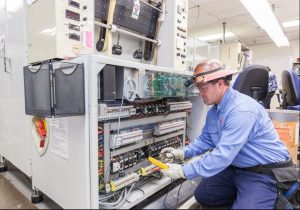 If your building’s electric power system hasn’t been modernized in a decade or more, and regularly maintained, then it may not have the capability for increased power demands such as electric-vehicle charging stations, and it could be a hazard to maintenance professionals and building tenants and visitors. Building owners and managers should have an analysis performed by a licensed power-system engineer every five years. That will give them confidence that they’re in compliance and won’t face Occupational Safety and Health Administration (OSHA) penalties or fines.
If your building’s electric power system hasn’t been modernized in a decade or more, and regularly maintained, then it may not have the capability for increased power demands such as electric-vehicle charging stations, and it could be a hazard to maintenance professionals and building tenants and visitors. Building owners and managers should have an analysis performed by a licensed power-system engineer every five years. That will give them confidence that they’re in compliance and won’t face Occupational Safety and Health Administration (OSHA) penalties or fines.
In addition, professional analysis will:
• Maximize the reliability of critical electrical systems, avoiding outages and costly downtime
• Improve the efficiency and extend the lifecycle of electrical equipment, reducing energy costs
• Supply safety information to subcontractors
• Provide documentation for lower insurance rates and workers’ compensation cases
Also, your analysis is only as good as your electrical system preventative maintenance program. The equipment must be properly operated and maintained to ensure the integrity of the analysis and the workplace safety of employees and contractors. A good electrical services provider should offer consulting, documentation and training for employees, enabling them to operate the power distribution system and minimize the risk. Engineers can recommend needed upgrades, tailor a preventative maintenance program to your facility’s needs and provide regular reporting to ensure that solutions are meeting predetermined goals.
In many cases, upgrading old equipment to remotely operated breaker controls and digital metering are worthwhile investments, not only from a safety perspective, but it also provides operators a wealth of data that can be utilized for energy-efficiency measures as well as system expansions, such as EV chargers. Electrical upgrades can help building managers to achieve their sustainability goals by digitalizing their power systems. Once you know the details of your power consumption, you can establish benchmarks and goals to measure your progress in becoming more energy efficient.
The trend is to digitalize everything. If you really want to track your energy usage and your carbon footprint, you’ve got to have access to the data. Having this data can allow owners to leverage remote monitoring, asset management and incident reporting, among other digital services. Current trends in the electrical space include adding Level II and Level III charging stations for electric vehicles (EVs) and installing distributed energy solutions to reduce costs and enhance resiliency and sustainability. Having charging stations onsite can be a differentiator for businesses and employers. As rental-car agencies and service vendors upgrade their fleets to EVs, building owners and managers are responding by adding more charging stations.
When demand is fluctuating on the grid, building managers and owners can reduce costs utilizing energy storage to purchase when rates are low and consume when they increase. Building managers also are installing distributed energy devices such as battery storage to power their buildings in the event of an outage. In some cases, these batteries complement rooftop solar panels, storing green electricity during daylight hours for use at night. In other cases, there is no renewable-energy component, and the batteries simply allow buildings to purchase electricity when demand and prices are low.

